Papers by Julie Henderson
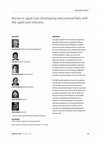
The paper outlines the Partnership in Aged Care Education (PACE) project established between the ... more The paper outlines the Partnership in Aged Care Education (PACE) project established between the School of Nursing and Midwifery at Flinders University and five industry partners in aged care. The aim of the project was to develop educational programs to support the development of the nursing workforce in aged care across the spectrum from novice to advanced practice. The aged care industry in Australia faces the dual challenges of a growing ageing population and a declining qualified nursing workforce. Education is widely viewed as one means of addressing this shortfall. A review of recent literature highlights concerns with the manner in which nursing education currently prepares nurses for aged care. The PACE project addresses issues of recruitment and retention of trained nursing staff within aged care through action research to identify and develop educational programs that are responsive to industry needs. The purposes of this project are to prepare registered nurses with an aged care focus at the entry level through an accountable curriculum, development of graduate nurse programs in residential aged care, continuing education programs for nursing staff within the aged care industry from care worker to nurse specialist and undergraduate and postgraduate courses that meet the practice needs of aged care nursing staff.
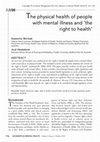
"An overview of literature was conducted on the 'right to health' for people with a mental illnes... more "An overview of literature was conducted on the 'right to health' for people with a mental illness, with a main focus on physical health. This included a review of key online databases for articles on the 'right to health', conducted for 2000-2010.
This paper provides evidence on the poor health status of people with mental illness. It then considers international human rights legislation and their context, including tensions presented by mental health legislation in terms of human rights. Dimensions of the 'right to health', issues and obstacles to fulfilment of the 'right to health', and opportunities and obstacles in the Australian context are explored.
There are many barriers to the recognition of right to health for the mentally ill. However, the new UN Convention on Persons with Disability offers some hope for the 'right to health' to be considered through legislative review and national policy."
Health and Social care in the community, 2017
Health Networks (PHNs) in Australia as part of a study of the impact of population health plannin... more Health Networks (PHNs) in Australia as part of a study of the impact of population health planning in regional primary health organisations on service access and equity.
Australian and new Zealand Journal fo Public Health
Objective: To examine the strength and extent of collaborations between primary health care organ... more Objective: To examine the strength and extent of collaborations between primary health care organisations and local government in population health planning.
Background: There is a growing nursing literature that views missed care as an inevitable consequ... more Background: There is a growing nursing literature that views missed care as an inevitable consequence of work intensification associated with the rationing of nursing and material resources available to deliver care. Global studies recognize that missed care is now ubiquitous, although studies tend to be conducted in one region, rather than nationwide. This study seeks to understand the Australian context of missed care.
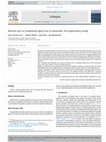
Collegian, 2017
Background: The phenomena of missed nursing care is usually measured through quantitative surveys... more Background: The phenomena of missed nursing care is usually measured through quantitative surveys that detail the specific tasks that are rationed or delayed, and the reasons why this is so. These studies report high levels of agreement within and across countries between the two major measures employed; the Kalisch's MISSCARE tool and the RN4Cast Basel Extent of Rationing of Nursing Care (BERNCA) instrument. Most of these studies have been conducted in acute care settings and demonstrate the impact of lack of human and other resources upon decisions to omit care. Less in known about missed care in residential aged care Aim: To explore the frequency and causes of missed care in residential aged care in three Australian states: New South Wales, Victoria and South Australia. Methods: Quantitative and qualitative data from 922 respondents working in residential aged care to the MISSCARE survey were bought together to identify the tasks missed in aged care and reasons for this. Findings: Respondents report the omission of unplanned care (toileting and answering bells) and reha-bilitative care. The primary reasons for missed care are staffing shortages and difficulties in meeting residents' complex health care needs due to demands arising from increased resident acuity and fewer skilled nurses to meet this demand. Conclusion: Resident care is missed in residential aged care with staffing numbers identified as a key cause. Problem Little is known about what care is missed and the causes of missed care in residential aged care. What is already known Missed care is widely reported in the acute sector related to limited access to staffing and resources; and poor communication and is associated with poorer outcomes for nurse sensitive indicators. What this paper adds Respondents identify missed care across all shifts in residential aged care related to staff levels, rising resident acuity and skill mix. (I. Blackman). Given recent changes in regulation and funding of aged care, missed care in residential aged care warrants further exploration.
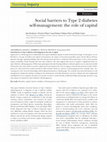
Nursing inquiry, 2014
Approaches to self-management traditionally focus upon individual capacity to make behavioural ch... more Approaches to self-management traditionally focus upon individual capacity to make behavioural change. In this paper, we use Bourdieu's concepts of habitus and capital to demonstrate the impact of structural inequalities upon chronic illness self-management through exploring findings from 28 semi-structured interviews conducted with people from a lower socioeconomic region of Adelaide, South Australia who have type 2 diabetes. The data suggests that access to capital is a significant barrier to type 2 diabetes self-management. While many participants described having sufficient cultural capital to access and assess health information, they often lacked economic capital and social capital in the form of support networks who promote health. Participants were often involved in social networks in which activities which are contrary to self-management have symbolic value. As a consequence, they entered relationships with health professionals at a disadvantage. We conclude that struct...
Cultural Sociology of Mental Illness: An A-to-Z Guide, 2014
Journal of Psychiatric and Mental Health Nursing, 2013

Nursing Inquiry, 2015
In this study, we argue that contemporary nursing care has been overtaken by new public managemen... more In this study, we argue that contemporary nursing care has been overtaken by new public management strategies aimed at curtailing budgets in the public hospital sector in Australia. Drawing on qualitative interviews with 15 nurses from one public acute hospital with supporting documentary evidence, we demonstrate what happens to nursing work when management imposes rounding as a risk reduction strategy. In the case study outlined rounding was introduced across all wards in response to missed care, which in turn arose as a result of work intensification produced by efficiency, productivity, effectiveness and accountability demands. Rounding is a commercially sponsored practice consistent with new public management. Our study illustrates the impact that new public management strategies such as rounding have on how nurses work, both in terms of work intensity and in who controls their labour.
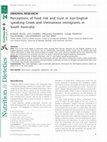
Nutrition & Dietetics, 2014
Aim: Trust in the food supply is important when making food choices. However for non-English spea... more Aim: Trust in the food supply is important when making food choices. However for non-English speakers in an English-speaking country, food choice may be problematic. Specifically, familiar foods may be limited and food safety information is often only communicated in English. This study aimed to identify factors that determine the nature and dimensions of consumer mis/trust in food in selected non-English-speaking populations. Methods: Semistructured, in-depth interviews with 17 non-English-speaking participants. Results: Qualitative analysis revealed that participants felt that they had no choice but to trust a food system that they did not understand well. However some participants undertook activities to mitigate risk and bolster their trust in the foods they bought and prepared. Conclusions: This study highlights a gap in culturally appropriate information for non-English speakers which can affect trust in the food supply.
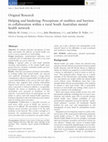
Australian Journal of Primary Health, 2013
To evaluate clinicians' perceptions of what helps and hinders the delivery of mental health care ... more To evaluate clinicians' perceptions of what helps and hinders the delivery of mental health care across a service network in a rural setting. Design: Qualitative, semistructured interviews were conducted with 10 individuals who work in one rural mental health care service network. Setting: A regional centre in rural South Australia involving representatives of the mental health team, general practice, hospital, community health and nongovernment organisations. Results: Clinicians' perceptions of barriers and enablers to working within their mental health care network were explored. Participants showed a strong shared commitment to effective mental health care delivery and a good understanding of the services that each offers. Interview data suggested that working relationships between local services could be perceived as stronger when a personal or historical element is recognisable. Similarly, the notion of familiarity and community involvement were perceived as facilitators in this network. A perceived barrier for participants was the failure to attract staff with mental health experience, leading to dependence upon the dedication and commitment of existing service providers. Conclusions: Collaboration is especially necessary in rural areas, where access to health care services is known to be difficult. The informality of relationships between service providers was shown to be the main facilitator in the network. This is both a strength as it promotes the communication between services and service providers that is essential for successful collabo-ration, yet is also a threat to the sustainability of the network based on the difficulties of staff recruitment and retention to rural settings.
British Food Journal, 2015
2015),"How food regulators communicate with consumers about food safety", British Food Journal, V... more 2015),"How food regulators communicate with consumers about food safety", British Food Journal, Vol. 117 Iss 8 pp. -Permanent link to this document: http://dx.

BMC public health, 2014
Previous research has shown that the media can play a role in shaping consumer perceptions during... more Previous research has shown that the media can play a role in shaping consumer perceptions during a public health crisis. In order for public health professionals to communicate well-informed health information to the media, it is important that they understand how media view their role in transmitting public health information to consumers and decide what information to present. This paper reports the perceptions of media actors from three countries about their role in reporting information during a food incident. This information is used to present ideas and suggestions for public health professionals working with media during food incidents. Thirty three semi-structured interviews with media actors from Australia, New Zealand and the United Kingdom were conducted and analysed thematically. Media actors were recruited via purposive sampling using a sampling strategy, from a variety of formats including newspaper, television, radio and online. Media actors said that during a food i...
Journal of Clinical Nursing, 2014

Uploads
Papers by Julie Henderson
This paper provides evidence on the poor health status of people with mental illness. It then considers international human rights legislation and their context, including tensions presented by mental health legislation in terms of human rights. Dimensions of the 'right to health', issues and obstacles to fulfilment of the 'right to health', and opportunities and obstacles in the Australian context are explored.
There are many barriers to the recognition of right to health for the mentally ill. However, the new UN Convention on Persons with Disability offers some hope for the 'right to health' to be considered through legislative review and national policy."
This paper provides evidence on the poor health status of people with mental illness. It then considers international human rights legislation and their context, including tensions presented by mental health legislation in terms of human rights. Dimensions of the 'right to health', issues and obstacles to fulfilment of the 'right to health', and opportunities and obstacles in the Australian context are explored.
There are many barriers to the recognition of right to health for the mentally ill. However, the new UN Convention on Persons with Disability offers some hope for the 'right to health' to be considered through legislative review and national policy."